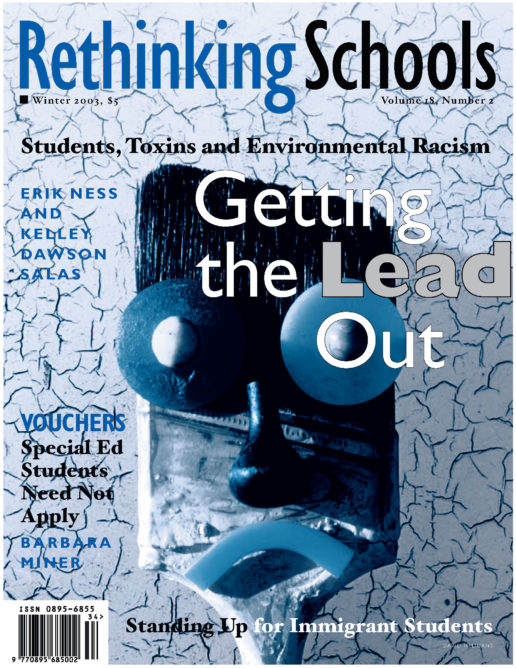Editorial: Standing Up for Immigrant Students
Illustrator: Susan Estelle Kwas

Like so many immigrants before them who have now become citizens and have been folded into the fabric of U.S. society, today’s immigrant children come to the United States with their families for many reasons: to escape political persecution or economic hardship, to seek education and work opportunities, or to be with family members who are already established here.
At this moment in history, the number of families who would like to immigrate to the United States greatly exceeds the number that the U.S. government is willing to accept. This is ironic, because U.S. economic and military policies often create the conditions whereby people need to flee their own countries for greater safety or economic security here. For example, U.S. military policies in Southeast Asia led to large waves of immigration from that region, while NAFTA has led to dramatic decreases in the price of corn in Mexico, making it more difficult for poor farmers to hold onto their land.
Because it is so hard to get permission to come to the United States, many families arrive without permission and are classified as undocumented. Lawmakers and the media often refer to undocumented immigrants as “illegal immigrants” or “illegal aliens.” Although most children have no part in their families’ decisions to immigrate without permission, they are called illegal as well, and receive the same scorn, resentment, and discrimination that is heaped upon their parents. And discrimination against undocumented children doesn’t stop at name-calling.
Being undocumented becomes a major issue for students who graduate from U.S. high schools and wish to continue on to college. Public universities in many states discriminate against undocumented youth by requiring them to pay out-of-state tuition, even if they have lived in the state since they were very young. To add insult to injury, undocumented students are currently prohibited from receiving federal loans or grants for college tuition. This puts higher education out of reach for most undocumented students.
Rethinking Schools supports federal and state legislation to charge in-state tuition to undocumented students who wish to attend public universities. Both the DREAM Act, which the U.S. Senate is currently considering, and a House bill called the Student Adjustment Act, would make that possible. These measures have one common goal: to allow states to charge undocumented students attending state universities in-state tuition instead of out-of-state tuition, which in most states is double or triple the cost.
Path to Citizenship
The DREAM Act goes even further: It provides a path for undocumented students to legalize their status and attain legal resident status. (See sidebar.)
There is also substantial work being done at the state level to remedy the unequal treatment undocumented students receive. Eighteen states are considering legislation that would end the practice of charging out-of-state tuition to undocumented students. (See “Immigrant Students Demand Higher Education,” page 12.) New York, Texas, Illinois, California, and several other states have already ended that practice.
Passage of the DREAM Act is vital to immigrant communities and to educators who work with immigrant populations. According to an article in the Chicago Tribune, seven million undocumented immigrants currently live in the United States. And, according to the National Immigration Law Center, 50,000-65,000 undocumented students graduate from U.S. high schools each year. Yet many lawmakers, educators, and citizens are unaware of how difficult it is for undocumented immigrants to legalize their status. Some wonder, “Why don’t they just become citizens?”
But citizenship and even permanent legal resident status are currently unattainable for the great majority of undocumented youth. The laws are complex and require expert legal help to navigate. The odds of legalizing one’s status, even with the help of a good lawyer, are slim. Ironically, joining the military is one of the easier ways that undocumented youth can currently achieve legal resident status.
Undocumented students are caught up in this dead-end situation through no fault of their own. The DREAM Act would take the focus off undocumented students’ current immigration status-after all, they did not decide to violate immigration law, but were brought to the United States by their parents. Instead, it focuses on immigrant students’ academic achievements and on preparing them to become fully contributing members of U.S. society.
Those students who will qualify to attain permanent resident status through the DREAM Act are students who have achieved academic success in U.S. schools despite the many challenges they faced. Undocumented immigrant students often surmount overwhelming obstacles that many U.S. citizens know very little about.
Children whose families immigrate without permission to the United States are sometimes separated from their parents for months or years. Later they are “sent for” and are sometimes brought by relatives, friends, or coyotes (smugglers), often making a difficult, risky passage across the U.S. border. Children become ill, suffer heat exhaustion, get injured, and sometimes die during these border crossings.
Once settled in their new U.S. communities, children begin to attend school and face another set of challenges: a new language, different cultural and academic expectations, standardized tests, and teachers and curriculum that may or may not take into account their previous educational experiences.
Despite the obstacles, a number of undocumented students do well in their classes in elementary, middle, and high school. They learn the language, do high quality academic work, receive good grades and honors, participate in extracurricular activities, and are leaders in their school communities. As graduation approaches, they share their classmates’ hopes of attending college. That’s when the double-edged sword presents itself: In many states, if you’re undocumented, you must pay out-of-state tuition and have no hope of getting federal financial aid.
Undocumented students (along with their teachers and parents) must feel intense frustration as this time draws near. The American Dream-“Work hard and you can achieve anything!”-holds no truth. As Krystal Rendan, a Latina high school student told Wisconsin legislators recently, “Every-body has a right to equal opportunity in this country. Isn’t that what the United States is supposed to be about, opportunity and equal rights? These students can’t determine their origin . . . College is going to benefit them and the community around them. They will have the chance to be what they want and fulfill their personal endeavors and prove to you and the whole world that they deserve it and can do it.”
We hope that community organizing and public debate around this issue will raise awareness among educators and the general public about the challenges that undocumented students face. It should also move us to examine our responsibility as educators and as a society for meeting the needs of all children and respecting their human right to education and self-improvement.
By passing the Student Adjustment Act and state legislation to charge in-state tuition to undocumented students, lawmakers will have the opportunity to end one kind of discrimination against undocumented students.By passing the DREAM Act, the Senate will go one step further and make residency attainable for college-bound undocumented students and provide a path to full citizenship. Lawmakers should pass this legislation, and educators should pressure them to do so. In doing so, we can acknowledge that we have a responsibility to all children to allow them to pursue their dreams.

